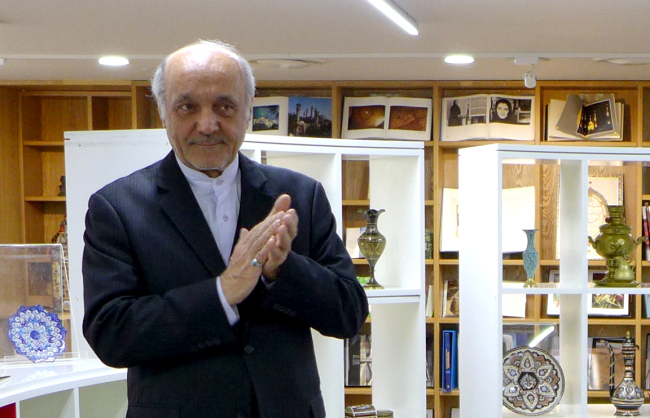The Iranian Embassy has organized an exhibition that sheds light on the country’s literary masterpieces spanning over a thousand years.
The event at the Seoul Metropolitan Library ― “For two eyes, for two hands, Persia” ― is a collection of Iran’s finest books, poems and folktales, as well as handicrafts and calligraphy, running until Jan. 24.
Organized to mark the 37th anniversary of the Iranian Revolution of January 1978-February 1979, the venue showcases works of Persian Gulf intellectuals: Omar Khayyam (1048-1131), Hafez (1325-90), Ferdowsi (935-1025), Saadi Shirazi (1210-91) and Mowlavi (1207-73).
“Books have been regarded as the highest delight of different cultures and civilizations. Books remove our ignorance and add to our knowledge. They enrich our intellect and experience,” Iranian Ambassador Hassan Taherian said at the opening ceremony Thursday.
“This precious occasion will play a bridging role in introducing our rich culture, lifestyle and philosophy to the Korean public.”
The event at the Seoul Metropolitan Library ― “For two eyes, for two hands, Persia” ― is a collection of Iran’s finest books, poems and folktales, as well as handicrafts and calligraphy, running until Jan. 24.
Organized to mark the 37th anniversary of the Iranian Revolution of January 1978-February 1979, the venue showcases works of Persian Gulf intellectuals: Omar Khayyam (1048-1131), Hafez (1325-90), Ferdowsi (935-1025), Saadi Shirazi (1210-91) and Mowlavi (1207-73).
“Books have been regarded as the highest delight of different cultures and civilizations. Books remove our ignorance and add to our knowledge. They enrich our intellect and experience,” Iranian Ambassador Hassan Taherian said at the opening ceremony Thursday.
“This precious occasion will play a bridging role in introducing our rich culture, lifestyle and philosophy to the Korean public.”

Iran, whose ethnic origins stretch back some 6,000 years to Central Asia, has a long literary heritage that peaked during the medieval period. Persian literature, as a linchpin of Oriental and Occidental civilizations, is viewed to have greatly influenced the discourses of India, Turkey, the Arabic world and Europe since the Middle Ages.
Unlike novels, which form the mainstay of European literature, in Iran poetry was the dominant mode of intellectual exercise. Until the introduction of European novels in the late 19th century, long narratives and prose were rare to find in Iran, according to scholars.
Works of respected poets such as Hafez were praised and reinterpreted by Germany’s Johann Wolfgang von Goethe (1749-1832), and a line of Saadi Shirazi decorates the wall of the United Nations building in New York: “The sons of Adam are limbs of each other, Having been created of one essence. When the calamity of time affects one limb, the other limbs cannot remain at rest. If you have no sympathy for the troubles of others, you are unworthy to be called by the name of a human.”
Despite the proliferation of poetry, Iranian literature has a rich tradition of tales and chronicles. Significant sections of “The Thousand and One Nights,” also known as “The Arabian Nights,” are thought to have originated from “A Thousand Tales” of Pahlavi literature, which in turn partly came from Indian folktales.
The most famous among Persian literature is Ferdowsi’s “Shahnameh,” an epic poem that recounts the mythical and historical past of the Persian Empire from the world’s creation to the Islamic conquest in the seventh century. Comprised of 60,000 verses ― making it the world’s longest poem ― Shahnameh is celebrated in Iran, Azerbaijan and Afghanistan, as well as Georgia, Armenia, Turkey and the Republic of Dagestan in Russia.
By Joel Lee (joel@herldcorp.com)
-
Articles by Korea Herald







![[KH Explains] How should Korea adjust its trade defenses against Chinese EVs?](http://res.heraldm.com/phpwas/restmb_idxmake.php?idx=644&simg=/content/image/2024/04/15/20240415050562_0.jpg&u=20240415144419)











![[Today’s K-pop] Stray Kids to return soon: report](http://res.heraldm.com/phpwas/restmb_idxmake.php?idx=642&simg=/content/image/2024/04/16/20240416050713_0.jpg&u=)